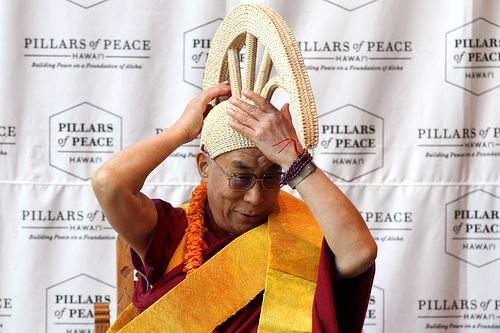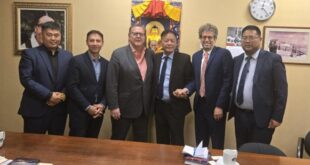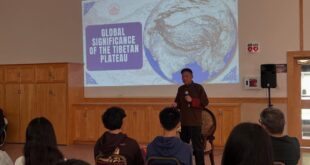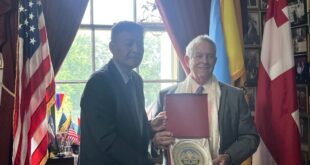Hawaii, April 14—His Holiness spoke about Educating the Heart to around 9500 students of Hawaii advising them about the importance of inner mental development for a wholesome education.
As he left the hotel for his engagement, he gave a brief audience to the small Tibetan community in Hawaiiin the hotel’s lobby. His Holiness inquired about the profession the people were involved in and told them not to forget their Tibetan identity. He stressed on the importance of preservation of the Tibetan culture and pointing to a person who was from Ladakh, he said that the Ladakhis had done much in this effort.
Thereafter, His Holiness went to the Bishop Museum, the largest museum in the state and the premier natural and cultural history institution in the Pacific. On his arrival, he was welcomed with a special chant. Young children of the ‘Aha Pūnana Leo Honolulu, an institution set up to promote Hawaii’s culture, sang a song of welcome. Thereafter, His Holiness went through the museum’s exhibitions. The Museum was established to house the collection of Hawaiian artifacts and royal family heirlooms of Princess Bernice Pauahi Bishop, the last descendant of the royal Kamehameha family ofHawaii. It has since expanded to include artifacts, documents and photographs about Hawai‘i and other Pacific island cultures. His Holiness asked about possible influence from other countries inHawaii’s culture.
At the end of his tour, His Holiness was presented with a traditional ceremonial hat (which he wore on his head mentioning that it seemed similar to Tibetan monastic hats), as well as a scarf specially woven by the staff of the museum.
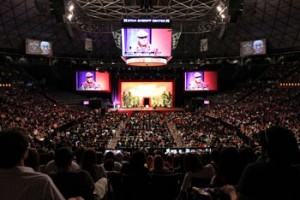
In brief remarks at the museum, His Holiness appreciated the gifts saying he looked upon them as theHawaiipeople’s acceptance of him as part of their community. He said this was a great honor. He referred to the Hawaiian people as an ancient people with cultural heritage, including language. His Holiness said that during his travels toLatin AmericaandEurope, he noticed that the indigenous people there were very determined to keep their culture and language. He said that in a similar way the Tibetan people had the same spirit.
His Holiness said that today the world was much civilized. He said most indigenous culture, including that of the Native Americans and the Japanese follower of Shintoism, had close feeling toward nature. He said that this was important adding that the technologically developed people should learn from this tradition and know that we cannot control nature or that we are above nature. He said people needed to realize that our survival depends on nature.
His Holiness also emphasized that the preservation of one’s own language was very essential. He said language was particularly essential for a living culture saying that museums were more for dead culture. His Holiness also said that additionally there was the need for a written script as mere oral linguistic tradition was not stable.
His Holiness said that hearing about the struggle of the people ofHawaiiin a way reminded him that we Tibetans also were carrying on a similar struggle.
His Holiness then went to the ‘Iolani Palace, the official residence of King Kalākaua and Queen Lili’uokalani, who were the last in a long line of ruling Hawaiian royalty, where he was welcomed by Princess Abigail Hawananakoa. He spent some time with the Princes inquiring about the origin and nature of the belief traditions among different communities inHawaii.
Thereafter, His Holiness went to theEast-WestCenterand was received by its President, Charles Morrison. He had lunch together with some of the event organizers.
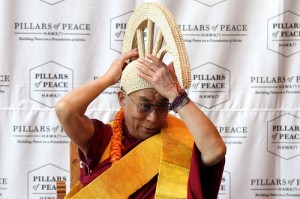
His Holiness then went to the Stan Sheriff Center, a multi-purpose arena on the campus of the University of Hawaii at Manoa, which is the venue of his talk to the students. At the Center, the University’s Chancellor, Virginia Hinshaw, and executive director of the Hawai’I Association of Independent Schools, Robert Witt, received him. As he entered the stage, Jack Johnson, an American folk rock musician, was performing a song. His Holiness greeted the singer and patted his knee much to the amusement of the gathering.
In his welcome address, Mr. Kelvin Taketa of the Hawaii Community Foundation said that there was hope that so many students had decided to spend a Saturday afternoon to attend the event. He talked about the inspiration behind the initiative of the event and introduced Mrs. Pam Omidyar. Mrs. Omidyar gave a brief biography of His Holiness the Dalai Lama and thanked him for an inspiration and a role model for peace.
His Holiness began his remarks by making the case that we were all same as humans, mentally, emotionally and physically. He recalled that some of the students who welcomed him on his arrival in Honolulu yesterday looked like Tibetans and so even physically there was the sameness.
He said everyone had the desire to achieve a happy life and that this was a basic right. He said the very purpose of life was to achieve happiness and joyfulness. However, happiness should not be understood merely at the level of physical happiness, he said. Physical happiness might sometimes bring about mental satisfaction, which in turn brings inner peace. He said happiness at the sensorial level was a physical one but mental happiness was superior and more effective. He explained this by saying that while physical ailment can be cured by mental peace, mental disturbance cannot be subdued at the physical level. He thus said there was the need to pay serious attention to mental happiness. His Holiness recalled being in the house of a rich American many years back and while using the rest room, he happened to peep into the medicine cabinet and found some tranquilizers. He said that this indicate that wealth was not in itself a solution for mental happiness.
However, His Holiness said that while there was much research about the external material reality, modern education had not paid adequate attention to the mental, emotional development until now. He said this clearly showed that modern education failed to reduce the gap between reality and appearance in terms of happiness.
Talking about mental happiness, His Holiness said the real destroyer of inner peace were things like fear and distrust. He said distrust leads to fear, which in turn leader to frustration and to anger. These lead to violence and applied at both the national level as well as the family level. He said trying to tackle these challenges through violence was not a winnable one and that only through non-violence could we approach them.
His Holiness said that here he was sharing his views based on his experience. However, although his experience was primarily through his Buddhist education, His Holiness said that he was approaching the issue at the human level, without touch the religion.
His Holiness then explained his concept of secular ethics saying that he subscribed to the definition of secularism as promoted by ancient Indian thoughts, namely respect for all religions, including respect to non-believers. He said secular ethics should be approached through common sense and common ethics and based on scientific findings. He explained research that showed that when people were calm the left side of the brain was more active while the right side became more active when people were filled with anger or hatred, etc.
His Holiness touched on the need to have more self-confidence with a sense of concern for other’s feelings as a way to reduce fear. He also talked about having respect for others, including one’s enemies saying this was not submitting to injustice. He then explained the nature of compassion and how it was at two levels, one biological and limited and the other unconditional.
He called for awareness on the value of inner positive thoughts and that this could be achieved through prayers but through warm-heartedness. His Holiness said that in this world some portion of the seven billion human beings did not practice the teachings of their religions although they consider themselves as believers.
Here he talked about the situation in India saying that although he love and respected India the attitude of some people who did ritual prayers but involved themselves in cheating in their daily lives. His Holiness said the people should either worship god and practice his teachings or worship money and do what ever they want. There was no third way, he added. As an aside, His Holiness mentioned here that when he had called himself a son ofIndiasome years back, some Chinese journalists questioned him on this thinking that he was making a political statement. However, he had explained his reason saying that mentally every portion of his brain was filled with the ancient Indian thoughts of the Nalanda tradition. He said physically, his body was sustained for more that five decades by Indian rice and dal (lentils) and by chapatti (Indian bread). His Holiness thought the Chinese journalists seemed to understand the context thereafter.
His Holiness then talked about his three commitments. He explained the first one by saying it was for promotion of non-violence and peace. He said this commitment was at the human level and that there was the need to develop positive mental attitude. He said his second commitment was for promotion of religious harmony and this was at the level of him being a Buddhist. He said all religions have the same message despite having philosophical differences. They all aimed at making good human beings. His Holiness said his third commitment was on the Tibetan struggle. He said after having transferred his temporal authority to an elected Tibetan leadership last year, he felt a little free on this now.
His Holiness then encouraged the students to think about ways to make life more peaceful. He said most of the students might be below the age of 30 and so belong to the 21st century. He said his generation belonged to the 20th century that had passed. He said it was up to the new generation to shape the 21st century into a peaceful one knowing that the 20th century was a violent one.
His Holiness explained that wanting the 21st century to be one of peace does not mean there will not be any problems. However, there will be better ways to approach these problems, through dialogue and mutual respect. Therefore, the young students should realize that they have a heavy responsibility, he concluded.
His Holiness then answered some questions, selected from among 2000 that were received online. To a question on what made him laugh, His Holiness responded that he did not laugh when he was alone for that would make people feel that he was mad. His laughter came through his interaction with people, their friendship and gesture. He said a smile has no barrier of language or culture.
When asked what he found most peaceful about Hawaii, he said that although he had been here a few times, this time it has been just a day and a half. In order to understand Hawaii properly and to differentiate between appearance and reality he would have to spend a longer period of time. Nevertheless, His Holiness said he was struck by Hawaii’s culture and heritage. He said it seemed very peaceful and closely connected with nature. He said this was important because nature creates humanity and if it is disturbed there would be problems of ecology, drinking water, Tsunami, etc.
To another question on how to approach the issue of showing compassion when there was no reciprocity, His Holiness recalled his explanation of two levels of compassions. He said in the compassion at the limited biological level, there might be problems, but genuine compassion was not dependent on the reaction of the other side or the expectation of something in return.
His Holiness said that human beings by nature have the capacity to be good without any conditions. He talked about the childhood stage when children interacted with each other at the same level without any consideration of background. Here he recalled the kindness of his mother, which spoiled him as a child, he said.
He said among students there was the need to develop a genuine sense of companionship. He competition was good if it is at the level of wanting to excel oneself and striving for that. However, extreme competition, which he defined as wanting to excel and in the process creating hindrance for others, was to be avoided. He advised the students to generate a sense of brotherhood and trust in their classrooms as such attitudes as bullying and fighting creates a negative atmosphere.
Following his remarks, three students sang an auspicious song. Thereafter, His Holiness was presented with a Hawaiin conchshell.
